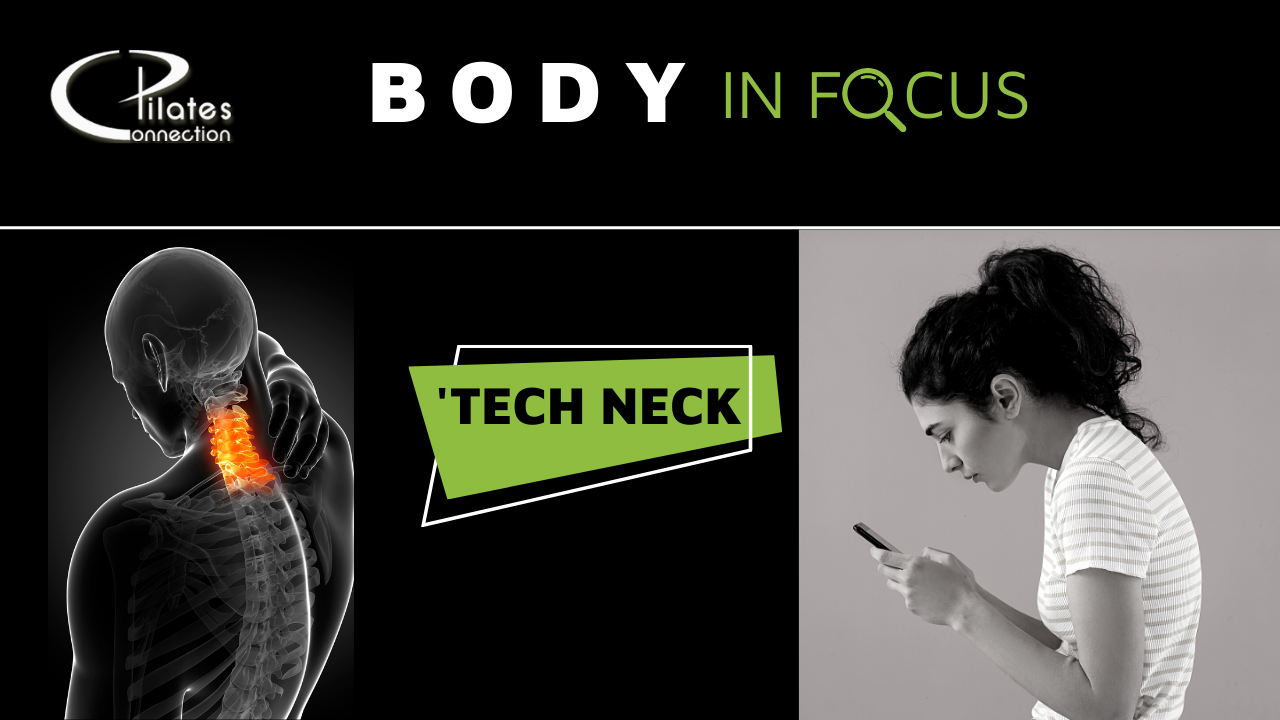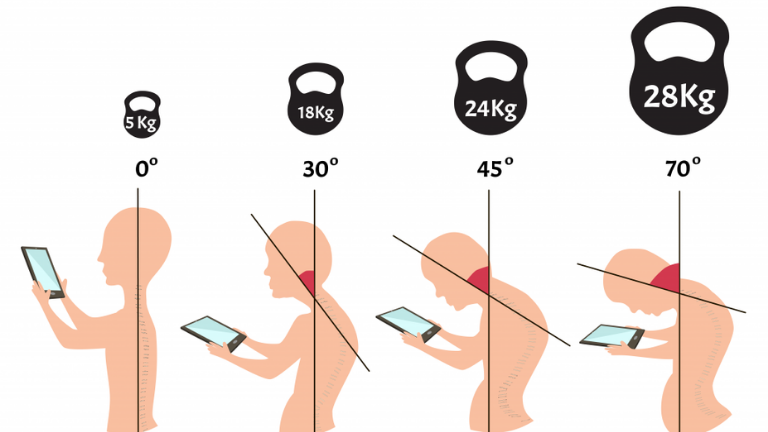
Body in Focus – Tech Neck
For the month of April, we are taking a deep dive into the all too common hunching over a phone, device or computer – commonly referred to as “Tech Neck” or “Text Neck”. In a nutshell, it’s neck pain that’s caused by repetitive strain and injury to the muscles and other tissue structures of the cervical spine. We’ve all come to love and rely on screen technology, with an ever-increasing number of adults, teens and even young kids, developing serious neck and back problems associated with Tech Neck.
This blog article explores why the weight and position of your neck matter, the symptoms of Tech Neck, and ways to prevent muscle and tissue damage around the neck and spine.
How much does my head weigh, and why does it matter?
On average, an adult’s head weighs anywhere between 4.5 – 5.5kg, and is supported by the muscles, ligaments, tendons and bony structures of the neck. But when you tilt your head forward and look down, which is the common posture for texting and looking at your phone or device, or sitting at your computer, the weight of your head places 24-28 kgs of force on the neck. The muscles in the back of the neck have to contract to hold your head up – the more you look down, the more the muscles have to work to keep your head up, causing fatigue and stress.
Your neck simply isn’t built to withstand that type of force for prolonged periods. The result is muscular and ligamentous strain and other structural issues that cause the symptoms associated with tech neck.

Common Symptoms of Tech Neck
Tech Neck symptoms commonly include one or more of the following:
- Generalised aching discomfort in the lower neck, shoulders, and upper back
- Sharp, stabbing pain that’s intense and localized in one spot
- Headaches
- Reduced mobility or stiffness in the neck, upper back, and shoulders
- Increased pain when tilting the head forward and looking down to text
- Jaw pain due to misalignment of the cervical spine
- Tingling pain and numbness in the arms and hands, related to spinal nerve irritation and inflammation
While initial symptoms can be mild, if left untreated, Tech Neck can cause serious long term problems. The muscles initially have to strain to hold your head up, but the muscles tighten, and, as they do, they put more pressure on the discs. That makes the discs wear out faster, and as the discs wear out faster, they can bulge or even rupture. If the ruptured disc pinches a nerve, you can get pain, weakness, or numbness in the arm, which may end up requiring surgical treatment. Long term postural problems can also occur as the muscles are conditioned to tilt the head and shoulders forward in a hunched position.
Preventing and reversing Tech Neck
Here are some tips on how to help prevent Tech Neck, and alleviate the symptoms:
- STAND UP and MOVE: This is especially true if you sit at a desk and work at a computer for large parts of the day. Take regular breaks away from your desk – stand up and walk around, or have a stretch (see some suggestions on our videos below). If you have an adjustable desk, try standing for periods and get the blood circulating through your body.
- OPTIMAL SCREEN POSITION: Ensure that your computer screen is at the correct height and distance away from your face, and you have a good quality chair that reclines with lumbar support. If you’re using a tablet or phone, try holding it up in a higher position, closer to your head, or using a stand on your lap if laying down watching / reading in bed.
- LEARN EXERCISES: to help stretch and relieve strained muscles in your back neck and shoulders, and regular exercise that focuses on strengthening these areas.
- FOCUS ON CORRECT POSTURE: Head up, shoulders back when you’re going about your daily life, whether it’s sitting, standing, or walking.
- SEEK PROFESSIONAL HELP: If symptoms continue to get worse and more persistent, consider seeing your GP or Physio. A tailored Pilates program with a seasoned instructor or myofascial release (also known as Structural Integration) may also help get you back on track faster.
Here are a couple of videos from Liane to show you how to release the strained muscles associated with Tech Neck:



Sorry, the comment form is closed at this time.